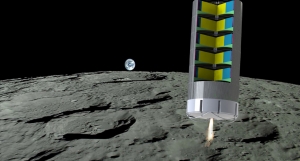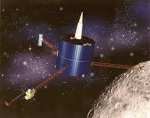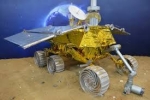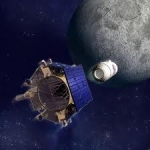Displaying items by tag: Moon
Multi-Task Logistic Module
The idea is to develop a modular logistic vehicle capable to provide in the future continuous logistic service between LEO and the Moon surface. Based on the use of a new structural concept in which the Payload cargo is retained via the use of airbag technology, the first time in Space technology, the goal is to demonstrate the structural performance of this new architecture with a scaled demonstrator to be tested in a Space laboratory. The modular characteristics will permit to launch in different missions Payload Modules and the Powered Module with orbital rendez-vous and docking, this will permit to host more propellant and send more payload mass to the Moon, as high as 6.3 Tons using advanced (restartable) LH2/LOX engine technology (at this stage even though the engine has not been identified it doesn't preclude the feasability of the concept, i.e it can be a scaled-down version of the Vinci engine). The Powered Module will mate with the Payload Modules with orbital rendezvous in LEO and once assembled the MTLM LH2/LOX engine shall provide the delta-V to go to the Moon and land. This kind of scenario that is different with respect to that of the EL3 mission has a much higher growth potential once fuel depots will be available in LEO and on the Moon surface, with the potential to guarantee a continuous logistic service between LEO and Moon. The idea is to exploit at best the availability of existing launchers such as Ariane 6. The retain of payload cargo via airbags once qualified can permit to simplify the requirements for the payload reducing its cost and this can give the opportunity to use this technology in other missions. Having airbags permanently inflated inside the Payload Module precompressing both the payload packages and the external retaining structure will permit to let the structure to work permanently in tension avoiding risks linked to buckling and this should significantly reduce the mass of the structure.
Lunar and Planetary Institute (LPI)
The Lunar and Planetary Institute is an American research institute that provides support services to NASA and the planetary science community, and conducts planetary science research under the leadership of staff scientists, visiting researchers, and postdoctoral fellows.
The Lunar and Planetary Institute (LPI) is dedicated to the study of the solar system, its formation, evolution, and current state. The Institute is part of the Universities Space Research Association (USRA) and is supported by the Science Mission Directorate of the National Aeronautics and Space Administration (NASA).
Located in Houston, Texas, USA, the LPI maintains an extensive collection of lunar and planetary data, carries out education and public outreach programs, and offers meeting coordination and publishing services. The LPI sponsors and organizes several workshops and conferences throughout the year including the Lunar and Planetary Science Conference (LPSC) held in March in the Houston area.
Lunar Prospector
Lunar Prospector was a NASA mission as part of the Discovery Program.
The 19-month mission was designed for a low polar orbit investigation of the Moon, including mapping of surface composition and possible polar ice deposits, measurements of magnetic and gravity fields, and study of lunar outgassing events.
The mission ended July 31, 1999, when the orbiter was deliberately crashed into a crater near the lunar south pole after the presence of water ice was successfully detected.
Data from the mission allowed the construction of a detailed map of the surface composition of the Moon, and helped to improve understanding of the origin, evolution, current state, and resources of the Moon. Several articles on the scientific results were published in the journal Science.
Barcelona Moon Team (BMT)
The Barcelona Moon Team (BMT) is a multidisciplinary joint venture bringing together entrepreneurial, industrial and academic capabilities representing the only Spanish based team at the Google Lunar X PRIZE.
Among its objectives are:
(1) to take the leadership in an ambitious space project. This important project elevates the Spanish aerospace sector to a leadership position in all the aspects related with the management and execution of a highly complex space mission. Thanks to this leadership position the national industry can play a role as a main contractor using its demonstrated experience and capabilities, meaning a competitive advantage. It is foreseen that these capabilities will help win contracts for our companies in the future.
(2) to foster the scientific and technical vocations and to retain talent; thanks to an extensive communications program with the aim to stimulate the participation of the general public in the event. In one hand scientific and technical careers will be encouraged among the youth, developing specialized knowledge workers for the future. In the other hand the attraction of international talent will bring new professionals and researchers from abroad, stopping the exodus of professionals and young graduates and doctors to other countries.
Lunar CATALYST
The Lunar CATALYST is a NASA project for the development of commercial robotic lunar lander capabilities.
Such capabilities could support commercial activities on the moon while enabling new science and exploration missions of interest to the larger scientific and academic communities.
NASA's new Lunar Cargo Transportation and Landing by Soft Touchdown (Lunar CATALYST) initiative calls for proposals from the U.S. private sector that would lead to one or more no-funds exchanged Space Act Agreements (SAA). The purpose of these SAAs would be to encourage the development of robotic lunar landers that can be integrated with U.S. commercial launch capabilities to deliver small and medium class payloads to the lunar surface.
Yutu rover
Yutu is a Chinese lunar rover which forms part of the Chang'e 3 mission to the Moon.
Launched on 1 December 2013, and landed on 14 December 2013. If successful it will be the first rover to operate on the Moon since Lunokhod 2 ceased operations in May 1973.
The official mission objective is to achieve China's first soft-landing and roving exploration on the Moon, as well as to develop and analyze key technological developments.
(Yutu, or Jade Rabbit, was a name selected in an online poll; it is a Chinese myth about a white pet rabbit of the Moon goddess Chang'e.)
LCROSS
The Lunar Crater Observation and Sensing Satellite (LCROSS) was a robotic spacecraft operated by NASA. It was launched in 2009.
The mission was conceived as a low-cost means of determining the nature of hydrogen detected at the polar regions of the moon.The main LCROSS mission objective was to explore the presence of water ice in a permanently shadowed crater near a lunar polar region. It was successful in discovering water in the southern lunar crater Cabeus.
It was launched together with the Lunar Reconnaissance Orbiter (LRO) on June 18, 2009, as part of the shared Lunar Precursor Robotic Program, the first American mission to the Moon in over ten years. Together, LCROSS and LRO form the vanguard of NASA's return to the Moon, and are expected to influence United States government decisions on whether or not to colonize the Moon.
LCROSS was designed to collect and relay data from the impact and debris plume resulting from the launch vehicle's spent Centaur upper stage (and data collecting Shepherding Spacecraft) striking the crater Cabeus near the south pole of the Moon.
Lunar Reconnaissance Orbiter (LRO)
The Lunar Reconnaissance Orbiter (LRO) is a NASA robotic spacecraft currently (April 2013) orbiting the Moon on a low 50 km polar mapping orbit.
The LRO mission is a precursor to future manned missions to the Moon by NASA. To this end a detailed mapping program will identify safe landing sites, locate potential resources on the Moon, characterize the radiation environment, and demonstrate new technology. The probe will make a 3-D map of the Moon's surface and has provided some of the first images of Apollo equipment left on the Moon. The first images from LRO were published on 2 July 2009, showing a region in the lunar highlands south of Mare Nubium (Sea of Clouds).
Launched on June 2009, in conjunction with the Lunar Crater Observation and Sensing Satellite (LCROSS), as the vanguard of NASA's Lunar Precursor Robotic Program, this is the first United States mission to the Moon in over ten years. LRO and LCROSS are the first missions launched as part of the United States's Vision for Space Exploration program.
Golden Spike
The Golden Spike Company is an American space transport startup company,with the objective to offer private commercial space transportation services to the surface of the Moon.
The company is planning to transform human space exploration by putting in place affordably priced lunar orbital and surface expeditions to the only natural satellite of the Earth – the Moon. Golden Spike will further transform human lunar exploration by making these missions participatory expeditions that involve the general public in ways that create exciting new ways to monetize human space exploration.
The name of the company is in reference to the ceremonial final spike placed in the First Transcontinental Railroad upon its completion.
Lunabotics Mining Competition
NASA's Annual Lunabotics Mining Competition is a university-level competition designed to engage and retain students in science, technology, engineering and mathematics (STEM).
NASA will directly benefit from the competition by encouraging the development of innovative lunar excavation concepts from universities which may result in clever ideas and solutions which could be applied to an actual lunar excavation device or payload. The challenge is for students to design and build an excavator, called a Lunabot, that can mine and deposit a minimum of 10 kilograms of lunar simulant within 10 minutes. The complexities of the challenge include the abrasive characteristics of the BP-1, the weight and size limitations of the Lunabot, and the ability to telerobotically or autonomously control the Lunabot from a remote mission control center. This year the scoring for the mining category will not be based primarily on the amount of material excavated in the allowed time but instead will require teams to consider a number of design and operation factors such as dust tolerance and projection, communications, vehicle mass, energy/power required, and full autonomy.










